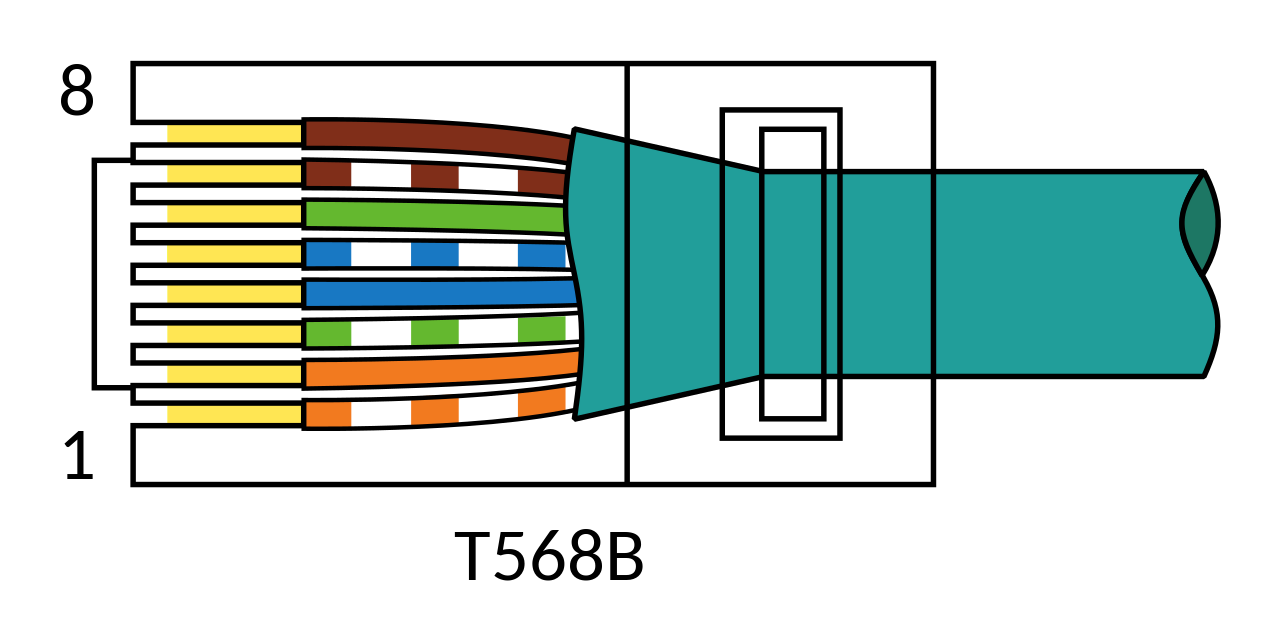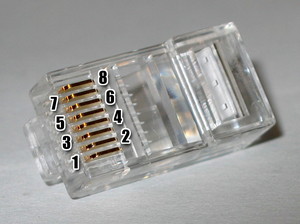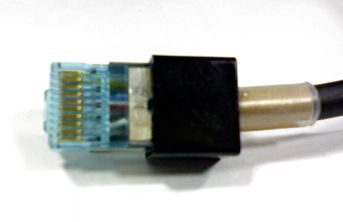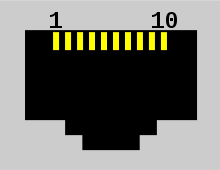RJ45 Network Connector
From: https://en.wikipedia.org/wiki/Modular_connector#8P8C
An 8P8C modular plug not yet crimped onto a cable
An 8P8C female modular connector with a key cut (the connector used in the
obsolete RJ45S specification)
The 8 position 8 contact (8P8C) connector is a modular connector commonly
used to terminate twisted pair and multi-conductor flat cable. These
connectors are commonly used for Ethernet over twisted pair, registered
jacks and other telephone applications, RS-232 serial communication using
the ANSI/TIA-568 (formerly TIA/EIA-568) and Yost standards, and other
applications involving unshielded twisted pair, shielded twisted pair, and
multi-conductor flat cable.
An 8P8C modular connection consists of a male plug and a female jack, each
with eight equally spaced contacts. On the plug, the contacts are flat metal
bars positioned parallel to the connector body. Inside the jack, the
contacts are metal spring wires angled away from the insertion interface.
When the plug is mated with the jack, the contacts meet and create an
electrical connection. The spring tension of the jack contacts ensures a
good interface.
Left: Generic 8P8C (or 8PMJ, 8-position modular jack) male connector. Right:
RJ45 male connector (with key)
Although commonly referred to as RJ45 in the context of Ethernet and
category 5 cables, RJ45 originally referred to a specific wiring
configuration of an 8P8C connector.[14][15][16] The original telephone
-system-standard RJ45 plug has a key that excludes insertion in an un-keyed
8P8C socket.[17]
The original RJ45S[a] was intended for high-speed modems and is obsolete.
The RJ45S jack mates with a keyed 8P2C modular plug,[18][19] and has pins 4
and 5 (the middle positions) wired for the ring and tip conductors of a
single telephone line and pins 7 and 8 shorting a programming resistor. This
is a different mechanical interface and wiring scheme than ANSI/TIA-568
T568A and T568B schemes with the 8P8C connector in Ethernet and telephone
applications. Generic 8P8C modular connectors are similar to those used for
the RJ45S variant, although the RJ45S plug is keyed and not compatible with
non-keyed 8P8C modular jacks.
Telephone installers who wired RJ45S modem jacks or RJ61X telephone jacks
were familiar with the pin assignments of the standard. However, the
standard un-keyed modular connectors became ubiquitous for computer
networking and informally inherited the name RJ45.
Standardization
The shape and dimensions of an 8P8C modular connector are specified for US
telephone applications by the Administrative Council for Terminal Attachment
(ACTA) in national standard ANSI/TIA-1096-A and international standard ISO
-8877. This standard does not use the short term 8P8C and covers more than
just 8P8C modular connectors, but the 8P8C modular connector type is the
eight-position connector type described therein, with eight contacts
installed.
For data communication applications (LAN, structured cabling), International
Standard IEC 60603 specifies in parts 7-1, 7-2, 7-4, 7-5, and 7-7 not only
the same physical dimensions but also high-frequency performance
requirements for shielded and unshielded versions of this connector for
carrying frequencies up to 100, 250 and 600 MHz.
Pinout
|
|
8P8C connectors are frequently terminated using the T568A or T568B
assignments that are defined in ANSI/TIA-568. The drawings to the right show
that the copper connections and pairing are the same, the only difference is
that the orange and green pairs (colors) are swapped. A cable wired as T568A
at one end and wired as T568B at the other end (Tx and Rx pairs reversed) is
an Ethernet crossover cable. Before the widespread acceptance of auto MDI-X
capabilities, a crossover cable was needed to interconnect similar network
equipment (such as Ethernet hubs to Ethernet hubs). Crossover cables are
sometimes still used to connect two computers together without a switch or
hub, however, most network interface cards (NIC) in use today implement auto
MDI-X to automatically configure themselves based on the type of cable
plugged into them. A cable wired the same at both ends is called a patch or
straight-through cable, because no pin/pair assignments are swapped. If a
patch or straight cable is used to connect two computers with auto MDI-X
capable NICs, one NIC will configure itself to swap the functions of its Tx
| 
|
| Pin
| T568A pair
| T568A color
| T568B pair
| T568B color
| 10BASE-T/100BASE-TX signal[20]
| 1000BASE-T/10GBASE-T signal
| Wire
| Diagram
|
| 1 | 3
| 
white/green stripe
| 2
| 
white/orange stripe
| TD+ | DA+ | tip
| 
Pin numbering on plug. Connected pins
on plug and jack have the same number.
|
| 2 | 3
| 
green solid
| 2
| 
orange solid
| TD− | DA− | ring
|
| 3 | 2
| 
white/orange stripe
| 3
| 
white/green stripe
| RD+ | DB+ | tip
|
| 4 | 1
| 
blue solid
| 1
| 
blue solid
| not used | DC+ | ring
|
| 5 | 1
| 
white/blue stripe
| 1
| 
white/blue stripe
| not used | DC− | tip
|
| 6 | 2
| 
orange solid
| 3
| 
green solid
| RD− | DB− | ring
|
| 7 | 4
| 
white/brown stripe
| 4
| 
white/brown stripe
| not used | DD+ | tip
|
| 8 | 4
| 
brown solid
| 4
| 
brown solid
| not used | DD− | ring
|
Types and compatibility
Two types of 8P8C plugs and crimping tools for installing the plug onto a
cable are commonly available: Western Electric/Stewart Stamping (WE/SS) and
Tyco/AMP. While the two types are similar, the tooling and plug types cannot
be interchanged.[b] WE/SS compatible plugs are available from a large number
of manufacturers, whereas Tyco/AMP plugs are produced exclusively by Tyco
Electronics.[citation needed] Both types of modular plugs can be mated with
a standard 8P8C modular jack.
Both types of 8P8C plugs are available in shielded and unshielded varieties
for different attenuation tolerances as needed. Shielded plugs are more
expensive and require shielded cable, but have a lower attenuation, and may
reduce electromagnetic interference.
Although a narrower 4-pin and 6-pin plug fits into the wider 8-pin jack and
makes a connection with the available contacts on the plug, because the body
of the smaller connector may stress the remaining contacts,[c] the smaller
connector can potentially damage the springs of the larger jack.
Applications
8P8C connectors are commonly used in computer networking applications, where
interconnecting cables are terminated at each end with an 8P8C modular plug
wired according to TIA/EIA standards. Most wired Ethernet communications are
carried over Category 5e or Category 6 cable terminated with 8P8C modular
plugs. The connector is also used in other telecommunications connections,
including ISDN and T1.
Where building network and telephone wiring is pre-installed, the center
(blue) pair is often used to carry telephony signals. While this allows an
RJ11 plug to connect, it may damage the modular jack; an approved converter
prevents damage. In landline telephony, an 8P8C jack is used at the point a
line enters the building to allow the line to be broken to insert automatic
dialing equipment, including intrusion alarm panels.
The EIA/TIA-561 standard describes the use of 8P8C connectors for RS-232
serial interfaces.[23] This application is common as a console interface for
network equipment, such as switches, routers, and headless computers.
8P8C modular connectors are also commonly used as a microphone connectors
for PMR, LMR, and amateur radio transceivers. Frequently the pinout is
different, usually mirrored (i.e. what would be pins 1 to 8 in the ANSI/TIA
-568 standard might be pins 8 to 1 in the radio and its manual).
In analog mobile telephony, the 8P8C connector was used to connect an AMPS
cellular handset to its (separate) base unit; this usage is now obsolete.
The physical connector is standardized as the IEC 60603-7 8P8C modular
connector with different categories of performance. The physical dimensions
of the male and female connectors are specified in ANSI/TIA-1096-A and ISO
-8877 standards and normally wired to the T568A and T568B pinouts specified
in the ANSI/TIA-568 standard to be compatible with both telephone and
Ethernet.
A similar standard jack once used for modem and data connections, the RJ45S,
used a keyed variety of the 8P8C body with an extra tab that prevents it
from mating with other connectors; the visual difference compared to the
more common 8P8C is subtle, but it is a different connector. The original
RJ45S[18][24] keyed 8P2C modular connector, obsolete today, had pins 5 and 4
wired for tip and ring of a single telephone line and pins 7 and 8 shorting
a programming resistor.
Electronics catalogs commonly advertise 8P8C modular connectors as RJ45. An
installer can wire the jack to any pin-out or use it as part of a generic
structured cabling system such as ISO/IEC 15018 or ISO/IEC 11801 using 8P8C
patch panels for both phone and data.
Crossover cables
A router-to-router crossover cable uses two 8-position connectors and a
unshielded twisted pair (UTP) cable with differently wired connectors at each end.
| |
|

The pin arrangement for a 10P10C socket
A 10P10C plug
|
The 10P10C connector is commonly referred to as an RJ50 connector, although
this was never a standard registered jack. The 10P10C has 10 contact
positions and 10 contacts.
The most common uses of the 10P10C connector are in proprietary data
transfer systems,[25] such as the Digiboard[26] and Equinox Systems' Super
-Serial multi-port TIA-232 adapters.[26] 10P10C connectors are also used to
implement RS-485 interfaces, and for data link connections in
uninterruptible power supplies.
|

|
This connector is also used by some vendors, for example, Cyclades (later
absorbed by Equinox) used pin 1 as an RI (ring indicator) signal, which is
seldom used, allowing an 8P8C plug to be inserted to their 10P10C socket for
most applications. The Cisco Systems STS-10X terminal server features this
connector. FordNet, a five-pair communications networking medium, also used
the 10P10C between terminals.
Motorola uses the 10-pin connector as a microphone connector in several of
their mobile radio product lines.[citation needed]
Polycom utilizes this connector on their Conference Link bus to connect
their HDX and Group Series codecs and microphones to their SoundStructure
audio mixers, although pins 1 and 10 are not used.[citation needed]
The 10-pin connector is also used by Demag Cranes AG in some pendant
connections. National Instruments is also using the 10p10c connector for
their NI 9237.[27]
MTS Systems Corporation is using the 10p10c connector for their MTS FlexTest
Controller Family.[citation needed]
Standards
- ANSI/TIA-968-A: Telephone terminal equipment: Technical requirements for
connection of terminal equipment to the telephone network at the Wayback
Machine (archived 2018-09-28)
- ANSI/TIA-1096-A: Telecommunications telephone terminal equipment
connector requirements for connection of terminal equipment to the telephone
network
- IEC 60603-7-1: Connectors for electronic equipment: Part 7-1: Detail
specification for 8-way, shielded free and fixed connectors with common
mating features, with assessed quality
- IEC 60603-7-2: Connectors for electronic equipment: Part 7-2: Detail
specification for 8-way, unshielded, free and fixed connectors, for data
transmissions with frequencies up to 100 MHz
- IEC 60603-7-4: Connectors for electronic equipment: Part 7-4: Detail
specification for 8-way, unshielded, free and fixed connectors, for data
transmissions with frequencies up to 250 MHz
- IEC 60603-7-5: Connectors for electronic equipment: Part 7-5: Detail
specification for 8-way, shielded, free and fixed connectors, for data
transmissions with frequencies up to 250 MHz
- IEC 60603-7-7: Connectors for electronic equipment: Part 7-7: Detail
specification for 8-way, shielded, free and fixed connectors, for data
transmissions with frequencies up to 600 MHz
- ISO/IEC 8877, EN 28877: Information Technology—Telecommunications and
Information Exchange between Systems—Interface Connector and Contact
Assignments for ISDN Basic Access Interface Located at Reference Points S
and T
- US government documents define registered jack applications of modular
connectors for telecommunications.[d] See Registered jack § History and authority
See also
Notes
- The often omitted S suffix indicates this is a wiring configuration
supporting a single telephone line.
- WE/SS and Tyco/AMP 8P8C plugs have different spacings for the cable strain
relief.[21][22] Using a WE/SS 8P8C crimp die set on a Tyco/AMP 8P8C plug crushes
the top of the connector and damages the crimp die set, and vice versa.
- The body of a 6P6C or 4P4C plug typically projects out by more than one
millimeter further than the contacts and presses the outermost contacts of the
larger connector further than if a full-size connector were inserted.
- 4P4C and 10P10C connectors are not defined in these standards.
References
Krumreich C.L., Mosing L.W., The Evolution of a Telephone, Bell Laboratories
Record 44(1) p.14 (January 1966)
Walden S.W., Telephone Sets Go Mod (Modular, That Is), Bell Laboratories
Record, Vol. 52(8) p. 238 (Sept. 1974)
AT&T, Registration Interface—Selection and General Information, Bell System Practices, Section 463-400-100 Issue 1, May 1976
FCC 47 CFR Part 68 Connection of Terminal Equipment to the Telephone Network, Section 68.502 superseded by T1.TR5-1999
"Six Conductor/Six Position Line Cord Module" (PDF). Bel-Stewart Connector. Bel. Retrieved 3 August 2021.
"RJ-45 Plug for Proposed CAT 6 Specifications" (PDF). Molex #449150001, Modular Plug, Category 6, Long Body, Unshielded, 8/8. Molex, LLC. Retrieved 3 August 2021.
"Six Conductor/Six Position Line Cord Module" (PDF). Bel-Stewart Connector. Bel. Retrieved 3 August 2021.
"RJ-45 Plug for Proposed CAT 6 Specifications" (PDF). Molex #449150001, Modular Plug, Category 6, Long Body, Unshielded, 8/8. Molex, LLC. Retrieved 3 August 2021.
"Universal Modular Plug".
BICSI (October 7, 2002). "Background Information". Telecommunications Cabling Installation (2nd ed.). McGraw-Hill Professional. p. 88. ISBN 0-07-140979-3. "4-position and 4-contact connectors are used primarily for telephone handset cords."
"Apple Macintosh Plus", My Old Computers, archived from the original on 2009-02-27, retrieved 2010-10-16.
"Mac Plus Keyboard Cable", Syrinx, UK: Megadon, "...the cable is the same as the telephone cable that connects handsets to the phone, unfortunately [...] this type of cable and pretty much any type of pre manufactured cable [...] is wired wrong for the Mac Plus. Under no circumstances should you use this cable as you will damage your keyboard and/or your Mac!"
"Direc TV Channel Control" (wiki). GB-PVR. Archived from the original on 2008-10-19. "Each end of a handset cord is wired opposite the other..."
Trulove 2005, pp. 23, 132: Designing LAN Wiring Systems: The 8-pin modular jack is sometimes referred to as an "RJ-45", because the connector/jack components are the same. However, RJ-45 actually applies to a special purpose jack configuration that is not used in LAN or standard telephone wiring. […] Work Area Outlets: Modular jacks are often referred to as "RJ-45" jacks. This is not really the correct moniker, although it is in very common use.
Oliviero, Andrew; Woodward, Bill (July 20, 2009). "Connectors". Cabling: The Complete Guide
to Copper and Fiber-Optic Networking (4th ed.). Sybex. p. 294. ISBN 978-0
-470-47707-6. "The RJ (registered jack) prefix is one of the most widely
(and incorrectly) used prefixes in the computer industry; nearly everyone,
including people working for cabling companies, is guilty of referring to an
eight-position modular jack (sometimes called an 8P8C) as an RJ-45."
Semenov, Andrey B.; Strizhakov, Stanislav K.; Suncheley, Igor R. (October 3,
2002). "Electrical Cable Connectors". Structured cable systems. Springer. p.
129. ISBN 3-540-43000-8. "The traditional 8-contact connector, which is
called Western Plug, 8PMJ (8-position modular jack), 8P8C (8 position 8
conductor), or somewhat incorrectly RJ-45, is used widely in SCS practice."
Trulove 2005, p. 219: User Cords and Connectors: This 8-pin modular plug is
probably the most subject to name abuse, because it resembles the
specialized RJ-45 connector. However, the RJ-45 wiring pattern (which
includes an interface programming resistor) is so radically different from
that of T568A and B that it really should not be called by that name at
all.
Modular jack wiring, Ontario, California: HVS, archived from the original on
2010-02-08
Modular wiring reference, Siemon
IEEE 802.3 14.5.1 MDI connectors
"Stewart Connector 937-SP-3088 – Eight conductor/eight position line cord
module" (PDF). Glen Rock, Pennsylvania: Bel Stewart Connector. 2006-02-01.
Archived from the original (PDF) on 2018-04-18. Retrieved 2018-04-18.
"Tyco/AMP 5-554739-2 – Modular plug assembly, 8 position, flat oval cable"
(PDF). Harrisburg, Pennsylvania: Tyco Electronics. 2008-03-31. Archived from
the original (PDF) on 2011-07-24. Retrieved 2009-09-10.
"RJ45", Layer 1, Zytrax.
"Modular Wiring Reference". Siemon. Retrieved 2010-10-14.
10 pin RJ50 (10P10C) male (connector diagram and applications), Pinouts
guide, archived from the original on 2013-05-18, retrieved 2010-10-17
Digi PortServer TS 10P10C (RJ50) Modular RS-232 pinout, Pinouts guide.
NI 9237 4-Channel, ±25 mV/V, 24-Bit Simultaneous Bridge Module
specifications.
Bibliography
Trulove, James (December 19, 2005), LAN wiring (3rd ed.), McGraw-Hill
Professional, ISBN 0-07-145975-8.
External links
Wikimedia Commons has media related to Modular connectors.
vte
Audio and video interfaces and connectors
vte
Unshielded and shielded twisted pair cabling standards
Categories:
Computer connectorsEthernetModularityNetworking hardwareTelephone
connectors










